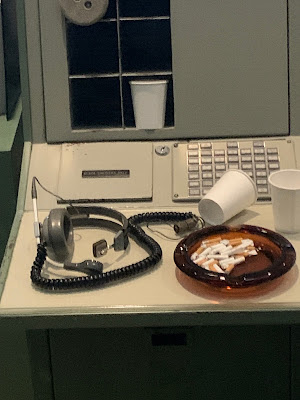On to the Houston area to see a few things.
Established as the Manned Spacecraft Center in 1961, the Lyndon B. Johnson Space Center (JSC) was named in honor of the late President. The center is responsible for the design, development, and operation of human space flight. For more than four decades, JSC has been the world leader in human space flight operations for NASA.
JSC is the training base and home for the nation's astronauts and the site of Mission Control where the flight controllers monitor the work of men and women in space.
We booked a tour of Mission Control but while we waited, we took in the many displays in the lobby area. A few interesting items caught our eyes (and our cameras).
International Space Station
For entertainment during their mission, astronauts often pack games in a personal locker. Astronaut Chamitoff packed this chess set with added fabric fasteners so the pieces wouldn't float away. During his rest time, he played with flight controllers around the world. Eventually a "Space vs. Earth" chess match was set up in which Chamitoff in space faced off against the third grade U.S. national chess championship team on Earth. People voted online on possible moves the team posted. Earth won.
The space trash disk was made by heating and compressing a sample of astronaut trash. When we go to the Moon and Mars, where resupply may not be possible, it will be harder to manage and dispose of trash. To address the problem, NASA is testing ways to compress and melt trash in space, replacing it to a solid flat tile like the one below.
Space trash disk and trash bag
There were several space suits on display.
Astronaut Wally Schirra wore this in-flight garment as he orbited Earth in 1968 during the Apollo 7 mission.
Charles "Pete" Conrad Jr. made history leading Apollo 12, the second mission to the Moon. This is the spacesuit he wore on the Moon and is one of only two spacesuits worn on the Moon on display outside the Smithsonian. If you look closely, you can see the Moon dust - unfortunately, I can't see it in the photo. As the first person on the Moon, Neil Armstrong's first words were "That's one small step for man, one giant leap for mankind." The first words Conrad spoke on the Moon were "Whoopie! Man, that may have been a small one for Neil, but that's a long one for me."
Astronaut Mike Collins wore this bio-isolation garment when he returned from the first Moon landing mission, Apollo 11, in 1969.
Astronaut Judy Resnik wore this suit when training on NASA's T-38 aircraft. It was the last NASA garment she wore before the Challenger accident in 1986.
Interesting to see some of the areas that the astronauts used during space flight.
Since 2004, the Longhorn Project has provided science lessons to thousands of students each year where the students participate in a hands-on genetics lesson utilizing the Texas Longhorns for data and visual evaluation. Students also learn about animal husbandry, fruit and vegetable cultivation, aquaculture, soil research and recycling technologies. They also discover how the knowledge relates to the future of human spaceflight.
There is a small steer herd that live at the Space Center for the duration of their lives, and a show team of longhorns on loan from members of the Texas Longhorn Breeders Association of American.
Inside this building is a Saturn V rocket which flew from 1967-1973. The rocket launched 26 astronauts into space with six successful missions landing men on the moon.
And then we pulled up to Mission Control.
This important site was named in 1985 to the U.S. National Register of Historic Places. Restoration of the Historic Landmark began in July, 2017 and was coordinated by JSC with funds raised by Space Center Houston. Located on the third floor of Building 30, five distinct, interrelated areas make up Apollo Mission Control. The historic Mission Operations Control Room includes the consoles used by flight controllers and large group display screen. Behind the screens in the summary display projection room, known as the "bat cave."
The restoration features the original consoles used to monitor nine Gemini, all Apollo Moon missions and 21 space shuttle missions. These missions include the flight of Apollo 11 that first landed men on the Moon, the Apollo 13 mission that famously experienced an in-flight emergency ("Houston, we have a problem"), and 40 other space missions.
We watched and listened to the actual broadcast of Apollo 11 landing on the moon. I remember that day like it was yesterday and being in the car going home from Santa Cruz with my sister at the wheel.
Although equipment in the building may change, the goal of the training facility remains the same. It houses almost 200 training courses to help astronauts become familiar with the spacecraft, understand the various systems and prepare for emergencies that may occur during a mission.
The facility has become the central hub for resolving issues during missions. If a problem were to occur aboard the ISS, officials would come to the facility to work through the situation with engineers, then relay the step-by-step process to the astronauts in orbit. This was depicted in the movie Apollo 13 by Gary Sinise playing astronaut Ken Mattingly as he was trying to solve the lack of battery power to get Apollo 13 home.
This is the model.
This is the real thing.
So big it was hard to get a photo
A nice photo as we left the grounds of the Apollo 11 astronauts.
Neil Armstrong, Michael Collins, Buzz Aldrin
What a day!





























How much time was there between the WWII museum and this museum? I am tired just reading about it all! I hope you had some days where you could just relax and not learn!!
ReplyDeleteIt was about a week between visits - I'm very behind on my blogging.
Delete